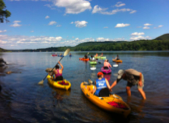
In Fall 2012 Professors Faull and Siewers brought elements from their two courses, Nature and Enlightenment and Visions of the Susquehanna together to form a new Interdisciplinary Perspectives class, called Susquehanna Country. The class was cross-listed in three separate academic departments or programs; English, Environmental Studies and Comparative Humanities. Aimed at those primarily in their second year at Bucknell, the course attracted students from many disciplines. It was also listed as a writing course, and satisfied the curricular requirements for Environmental Connections, Arts and Humanities Learning Goals, and Community-Based Learning.
Like its precursors, the class incorporated a great deal of experiential learning and hence Faull and Siewers designed the week’s classes around a three-hour “humanities lab.” During this extended block students were able to go on local field trips, go kayaking on the river, visit local museums and historical societies, and also workshop on digital projects, either creating maps that narrated stories of the Susquehanna Country in Google Earth or produce WordPress sites on a topic of their choice. These final collaborative projects included mapping the action around Lake Glimmerglass in James Fenimore Cooper’s novel, The Deerslayer; mapping the massacres of Moravian mission sites in Pennsylvania and Ohio; producing a fictional blog written from the perspective of a colonial woman missionary. The class also made an overnight field trip to the Onondago Longhouse as guests of the Onondago nation and to Cooperstown, NY to visit sites associated with the Cooper family.
Over the course of the semester the class examined the interconnectedness of environment, philosophy, literature and human communities in the Susquehanna region during the 18th and early 19th centuries, a time when the Susquehanna River functioned among different cultures as both border and connecting corridor. It also explored: 1) Enlightenment and Native notions of nature, and how the two interacted in the region during the removal of American Indian nations from the watershed, as well as their evolving shared vocabularies of existence as they pertain to nature and the human body; and 2) how British and early American authors such as James Fenimore Cooper and Susan Fenimore Cooper and Joseph Priestley, sought to develop new “native” ideas of nature in relation to the Susquehanna as a type of “new Eden,” in response to emerging new technological worldviews. Students also engaged with contemporary Native American communities and current environmental issues and conservation projects in “Susquehanna country.” The course finally considered whether there are lessons from alternative views of the past for our development of ecological restoration and sustainable community in the region today.